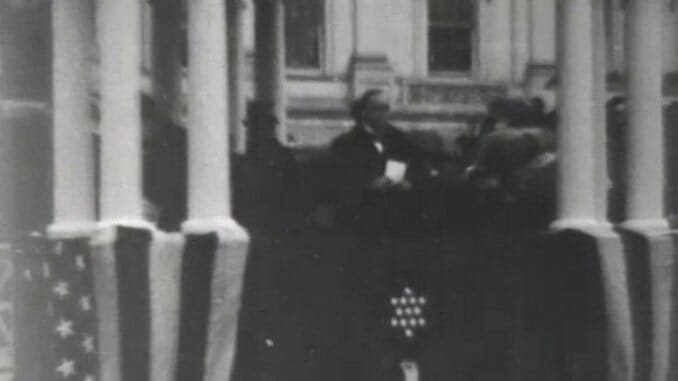We’re All Watching the Presidential Inauguration from Afar. 120 Years Ago, Americans Did the Same for the First Time

A presidential inauguration is a historic event no matter when it comes along, and that of Joe Biden is exceptional in a number of ways—not least of which is that it finally gets rid of the first and only President to be impeached twice. But one of the more significant factors is that Biden will be sworn in without an in-person audience due to health and safety precautions. As you watch Biden take the oath of office, either on TV or YouTube, you’ll be part of a grand tradition of remote viewing going back since the very beginning of the 20th century. Sure, there were radio events and news coverage for those that couldn’t previously attend to see the country’s new leader in the flesh, but that changed at the turn of the century—and that change’s unassuming potency can still be viewed today. President William McKinley’s 1901 inauguration is included in the Library of Congress’ National Film Registry, allowing us to experience this important piece of American political pageantry both now and 120 years ago.
President McKinley was the first president to have his inauguration filmed (in 1897) and the first president to be filmed in general (during his first race against William Jennings Bryan in 1896). According to Daniel Eagan’s America’s Film Legacy: The Authoritative Guide to the Landmark Movies in the National Film Registry, this campaign footage was welcomed by such “great applause” by audiences that it caused a “pandemonium” when it was screened. For context, this is the same year that the Lumières’ Train Pulling into a Station rocked people’s worlds. Imagine all that train hubbub, but for the person that would lead your country.
That first race aside, it’s McKinley’s inauguration for his second term that made it into the National Film Registry. Here’s President McKinley Taking the Oath, which is part of a two-part film made by Edison crews that also saw him riding up to the ceremony with his escort:
Ok, so it’s pretty rough. Sent as paper prints to the Library of Congress, these movies were shot on cameras without tripods that move like we expect—pans, tilts and the like were more trouble than they were worth, especially if you were waiting for a blink-and-you-miss-it shot of the President of the United States. Cameramen Edwin S. Porter (the prolific pioneer behind The Great Train Robbery) and James H. White (similarly prolific, with over 500 directing credits) put those cameras down and let life walk by. Sometimes literally, as people body-block the view.
But you still get a sense of excitement, of joy, from the proceedings. McKinley was coming in hot off a revitalized economy and a quickly won war. His VP, Theodore Roosevelt, was a total stud. There are empty chairs and umbrellas (it started raining hard right when McKinley began to speak), but the crowd beneath is a thrumming mass that noticeably stills when the oath-taking begins. It’s a touching, timeless piece of silent cinema that prioritizes closeness and awe—while still humanizing the highest office like no other art form. It’s a sense that’s almost hard to remember coming off of a President so thoroughly despised.
120 years later, as America has come to terms with movie star Presidents and Presidents that cameoed in Home Alone 2, the relationship of the Presidency to film has evolved in unthinkable ways. Perhaps it’s coming back around to a pleasant and exciting way to feel close to our most powerful representative—it’s certainly better than dreading every half-assed video that flops its way onto Twitter. Today, at least, cheers and tears alike will reverberate through time with those from the first Americans to ever see their President sworn in on film. On the day of this purely ceremonial event, it’s worth checking in with history to gain some perspective on the country’s relationship with its leader and its motion pictures, and worth allowing yourself a little joy from an imperfect victory and an optimistic future.
Jacob Oller is Movies Editor at Paste Magazine. You can follow him on Twitter at @jacoboller.
For all the latest movie news, reviews, lists and features, follow @PasteMovies.







































